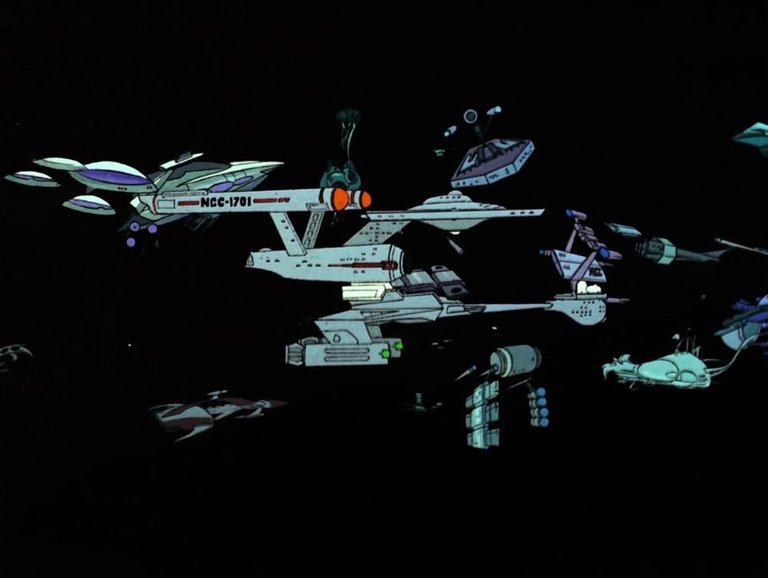Television Review: The Time Trap (Star Trek: The Animated Series, S1X12, 1973)

The Time Trap (S01E12)
Airdate: November 24th 1973
Written by: Joyce Perry
Directed by: Hal Sutherland
Running Time: 22 minutes
Today, Star Trek: The Animated Series (TAS) is often overlooked in discussions of the franchise’s evolution, yet it occupies a pivotal role as both a sequel to The Original Series (TOS) and a bridge to the Golden Age of Star Trek that would unfold in the 1980s and ’90s. While the series maintained the foundational ethos of TOS—exploring ethical dilemmas, interstellar diplomacy, and the human condition—it also boldly introduced ideas and themes that would later become cornerstones of the franchise’s enduring appeal. The Time Trap, one of TAS’s most ambitious episodes, exemplifies this duality: it not only honours TOS’s legacy but also pioneers concepts that would resonate in films and later series such as Deep Space Nine and Voyager. By juxtaposing familiar characters with bold narrative risks, The Time Trap underscores TAS’s unique position as a transitional work that dared to push the boundaries of what Star Trek could achieve.
The episode opens with the USS Enterprise venturing into the Delta Triangle, a mysterious region of space notorious for swallowing entire starships whole. Captain Kirk’s mission is to uncover the truth behind these disappearances, a task that soon collides with classic Trek geopolitical tension. A skirmish with a Klingon battlecruiser commanded by the iconic villain Captain Kor escalates abruptly when the Klingon ship vanishes mid-battle, seemingly unharmed by the Enterprise’s phasers and photon torpedoes. Pursued by two more Klingon vessels, the Enterprise ventures deeper into the Triangle, where it encounters strange spatial distortions. These anomalies reveal that the ship—and its predecessors, including Kor’s crew—has crossed into a parallel universe.
Here, the Enterprise discovers a colossal graveyard of derelict ships, home to the descendants of crews who vanished centuries ago. These survivors, now united as the Elysian society, have transcended racial and ideological divides to build a harmonious utopia. Led by Xerius, a Romulan elder, the Elysians explain that escaping this dimension is impossible. Yet Kirk and Kor—longtime adversaries—reluctantly collaborate to pool their resources and engineer a return. However, Kor’s distrust resurfaces when he attempts to sabotage the Enterprise by planting explosives, a scheme foiled by Magen, an Elysian with psychic abilities. Ultimately, both ships escape, with Kirk magnanimously allowing Kor to claim the victory as his own, a gesture underscoring Trek’s recurring theme of diplomacy over conquest.
One of The Time Trap’s strengths lies in its continuity with TOS through the return of Kor, the first Klingon character to appear in the franchise. Originally played by John Colicos in Errand of Mercy and later in Deep Space Nine, here the role is taken by James Doohan (better known as Scotty). This callback to TOS’s inaugural Klingon villain—whose rivalry with Kirk defined key episodes—ties the animated series to its live-action predecessor while also hinting at the complex relationships that would define later Trek eras. Kor’s presence also foreshadows his later development in DS9, where his evolution from antagonist to reluctant ally becomes a narrative touchstone.
The episode’s universe-building extends to its inclusion of numerous TOS races, such as Andorians, Romulans, and Orions. Notably, it also introduces new species, subtly expanding Trek’s lore. However, the portrayal of the Orion slave girl—a character clad in skimpy attire—reveals TAS’s occasional reliance on fan service, even in an ostensibly family-friendly medium.
The episode’s central premise—a cosmic “Bermuda Triangle” trapping ships in a parallel dimension—is both inventive and thematically rich. Writer Joyce Perry elevates this concept by introducing the Elysians, a society forged from the ashes of conflict. Their utopia, where former enemies collaborate to survive, challenges Trek’s usual focus on conflict resolution in the present and instead imagines a future where adversarial races must transcend their differences to endure. The enforced collaboration between Kirk and Kor further amplifies this theme, mirroring the diplomatic tensions and eventual alliances that would define later Trek films and series. Perry’s twist—a resolution that demands cooperation over competition—elevates The Time Trap above typical “away mission” episodes, offering a meditation on unity in the face of existential threats.
Despite its strengths, The Time Trap stumbles under the weight of its own ambition. The subplot in which Kor sabotages the Enterprise—a transparent ploy to prolong tension—feels tacked-on and undermines the episode’s earlier themes of mutual respect. The Elysians, while intriguing, are underdeveloped, their society’s governance and culture barely addressed beyond vague references to harmony. This lack of exposition leaves their utopia feeling more like a deus ex machina than a fully realised world, a flaw likely exacerbated by TAS’s limited runtime. Additionally, Magen’s psychic abilities, critical to resolving the sabotage, are introduced abruptly, diminishing their impact. These missteps suggest that The Time Trap’s narrative could have benefited from tighter scripting and deeper characterisation, particularly given its complex premise.
At the end of the day, The Time Trap is an uneven but compelling entry in TAS’s canon. Its exploration of parallel universes, utopian societies, and adversarial alliances prefigures themes that would define Star Trek’s Golden Age, even as its rushed pacing and unresolved subplots weaken its narrative cohesion. Decades later, the episode’s influence endures: Voyager’s The Void (2001) directly borrows its premise of a cosmic graveyard trapping ships and their crews, though it refines the concepts TAS introduced. For all its shortcomings, The Time Trap remains a testament to TAS’s ambition—a series that, despite its niche status, dared to innovate while safeguarding the legacy of TOS.
RATING: 5/10 (++)
Blog in Croatian https://draxblog.com
Blog in English https://draxreview.wordpress.com/
InLeo blog https://inleo.io/@drax.leo
LeoDex: https://leodex.io/?ref=drax
InLeo: https://inleo.io/signup?referral=drax.leo
Hiveonboard: https://hiveonboard.com?ref=drax
Rising Star game: https://www.risingstargame.com?referrer=drax
1Inch: https://1inch.exchange/#/r/0x83823d8CCB74F828148258BB4457642124b1328e
BTC donations: 1EWxiMiP6iiG9rger3NuUSd6HByaxQWafG
ETH donations: 0xB305F144323b99e6f8b1d66f5D7DE78B498C32A7
BCH donations: qpvxw0jax79lhmvlgcldkzpqanf03r9cjv8y6gtmk9